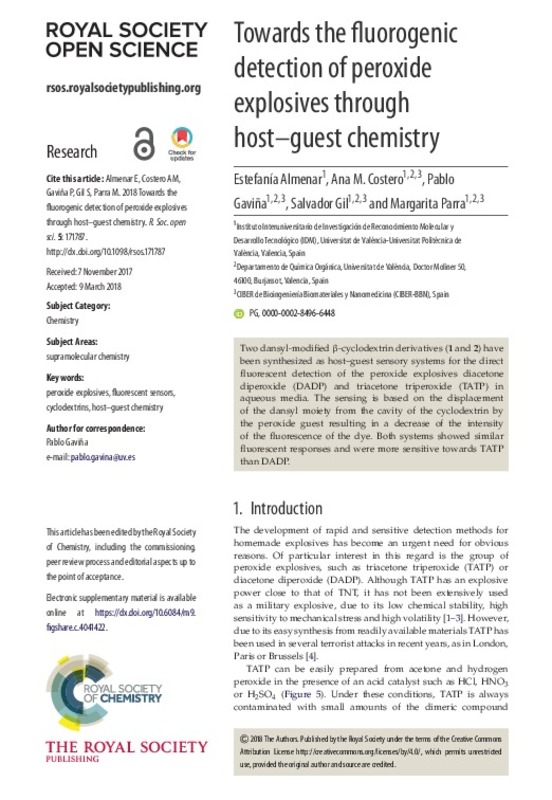Dubnikova, F., Kosloff, R., Almog, J., Zeiri, Y., Boese, R., Itzhaky, H., … Keinan, E. (2005). Decomposition of Triacetone Triperoxide Is an Entropic Explosion. Journal of the American Chemical Society, 127(4), 1146-1159. doi:10.1021/ja0464903
Fitzgerald, M., & Bilusich, D. (2011). Sulfuric, Hydrochloric, and Nitric Acid-Catalyzed Triacetone Triperoxide (TATP) Reaction Mixtures: An Aging Study. Journal of Forensic Sciences, 56(5), 1143-1149. doi:10.1111/j.1556-4029.2011.01806.x
Matyáš, R., Pachman, J., & Ang, H.-G. (2009). Study of TATP: Spontaneous Transformation of TATP to DADP - Full Paper. Propellants, Explosives, Pyrotechnics, 34(6), 484-488. doi:10.1002/prep.200800043
[+]
Dubnikova, F., Kosloff, R., Almog, J., Zeiri, Y., Boese, R., Itzhaky, H., … Keinan, E. (2005). Decomposition of Triacetone Triperoxide Is an Entropic Explosion. Journal of the American Chemical Society, 127(4), 1146-1159. doi:10.1021/ja0464903
Fitzgerald, M., & Bilusich, D. (2011). Sulfuric, Hydrochloric, and Nitric Acid-Catalyzed Triacetone Triperoxide (TATP) Reaction Mixtures: An Aging Study. Journal of Forensic Sciences, 56(5), 1143-1149. doi:10.1111/j.1556-4029.2011.01806.x
Matyáš, R., Pachman, J., & Ang, H.-G. (2009). Study of TATP: Spontaneous Transformation of TATP to DADP - Full Paper. Propellants, Explosives, Pyrotechnics, 34(6), 484-488. doi:10.1002/prep.200800043
Matyas, R., Pachman, J., & Ang, H.-G. (2008). Study of TATP: Spontaneous Transformation of TATP to DADP. Propellants, Explosives, Pyrotechnics, 33(2), 89-91. doi:10.1002/prep.200700247
Wang, J. (2007). Electrochemical Sensing of Explosives. Electroanalysis, 19(4), 415-423. doi:10.1002/elan.200603748
Bauer, C., Willer, U., Lewicki, R., Pohlkötter, A., Kosterev, A., Kosynkin, D., … Schade, W. (2009). A Mid-infrared QEPAS sensor device for TATP detection. Journal of Physics: Conference Series, 157, 012002. doi:10.1088/1742-6596/157/1/012002
Widmer, L., Watson, S., Schlatter, K., & Crowson, A. (2002). Development of an LC/MS method for the trace analysis of triacetone triperoxide (TATP). The Analyst, 127(12), 1627-1632. doi:10.1039/b208350g
Zhang, Y., Ma, X., Zhang, S., Yang, C., Ouyang, Z., & Zhang, X. (2009). Direct detection of explosives on solid surfaces by low temperature plasma desorption mass spectrometry. The Analyst, 134(1), 176-181. doi:10.1039/b816230a
Girotti, S., Ferri, E., Maiolini, E., Bolelli, L., D’Elia, M., Coppe, D., & Romolo, F. S. (2011). A quantitative chemiluminescent assay for analysis of peroxide-based explosives. Analytical and Bioanalytical Chemistry, 400(2), 313-320. doi:10.1007/s00216-010-4626-3
Walter, M. A., Panne, U., & Weller, M. G. (2011). A Novel Immunoreagent for the Specific and Sensitive Detection of the Explosive Triacetone Triperoxide (TATP). Biosensors, 1(3), 93-106. doi:10.3390/bios1030093
Sella, E., & Shabat, D. (2008). Self-immolative dendritic probe for direct detection of triacetone triperoxide. Chemical Communications, (44), 5701. doi:10.1039/b814855d
Germain, M. E., & Knapp, M. J. (2008). Turn-on Fluorescence Detection of H2O2and TATP. Inorganic Chemistry, 47(21), 9748-9750. doi:10.1021/ic801317x
Lin, H., & Suslick, K. S. (2010). A Colorimetric Sensor Array for Detection of Triacetone Triperoxide Vapor. Journal of the American Chemical Society, 132(44), 15519-15521. doi:10.1021/ja107419t
Li, Z., Bassett, W. P., Askim, J. R., & Suslick, K. S. (2015). Differentiation among peroxide explosives with an optoelectronic nose. Chemical Communications, 51(83), 15312-15315. doi:10.1039/c5cc06221g
Askim, J. R., Li, Z., LaGasse, M. K., Rankin, J. M., & Suslick, K. S. (2016). An optoelectronic nose for identification of explosives. Chemical Science, 7(1), 199-206. doi:10.1039/c5sc02632f
Ueno, A., Minato, S., Suzuki, I., Fukushima, M., Ohkubo, M., Osa, T., … Murai, K. (1990). Host–Guest Sensory System of Dansyl-Modifled β-Cyclodextrin for Detecting Steroidal Compounds by Dansyl Fluorescence. Chemistry Letters, 19(4), 605-608. doi:10.1246/cl.1990.605
Hamasaki, K., Ikeda, H., Nakamura, A., Ueno, A., Toda, F., Suzuki, I., & Osa, T. (1993). Fluorescent sensors of molecular recognition. Modified cyclodextrins capable of exhibiting guest-responsive twisted intramolecular charge transfer fluorescence. Journal of the American Chemical Society, 115(12), 5035-5040. doi:10.1021/ja00065a012
Ikeda, H., Nakamura, M., Ise, N., Oguma, N., Nakamura, A., Ikeda, T., … Ueno, A. (1996). Fluorescent Cyclodextrins for Molecule Sensing: Fluorescent Properties, NMR Characterization, and Inclusion Phenomena ofN-Dansylleucine-Modified Cyclodextrins. Journal of the American Chemical Society, 118(45), 10980-10988. doi:10.1021/ja960183i
Ueno, A., Kuwabara, T., Nakamura, A., & Toda, F. (1992). A modified cyclodextrin as a guest responsive colour-change indicator. Nature, 356(6365), 136-137. doi:10.1038/356136a0
Ogoshi, T., & Harada, A. (2008). Chemical Sensors Based on Cyclodextrin Derivatives. Sensors, 8(8), 4961-4982. doi:10.3390/s8084961
6A-O-p-TOLUENESULFONYL-b-CYCLODEXTRIN. (2000). Organic Syntheses, 77, 225. doi:10.15227/orgsyn.077.0225
Tang, W., & Ng, S.-C. (2008). Facile synthesis of mono-6-amino-6-deoxy-α-, β-, γ-cyclodextrin hydrochlorides for molecular recognition, chiral separation and drug delivery. Nature Protocols, 3(4), 691-697. doi:10.1038/nprot.2008.37
Mourer, M., Hapiot, F., Monflier, E., & Menuel, S. (2008). Click chemistry as an efficient tool to access β-cyclodextrin dimers. Tetrahedron, 64(30-31), 7159-7163. doi:10.1016/j.tet.2008.05.095
Eaton, D. F. (1988). Reference materials for fluorescence measurement. Pure and Applied Chemistry, 60(7), 1107-1114. doi:10.1351/pac198860071107
[-]








